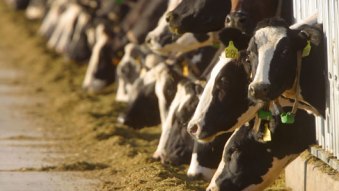 For almost as long as they’ve been in use, factory farms have been synonymous with three kinds of problems: environmental, nutritional, and ethical. But today, new data compels us to consider an overlooked fourth category: economic. Scheduled for release in September 2013, the book Meatonomics looks at the strange economic forces behind meat and dairy production – and how those forces affect consumers and taxpayers. It’s a new look at a bizarre, upside-down industry, and its revelations are shocking.
For almost as long as they’ve been in use, factory farms have been synonymous with three kinds of problems: environmental, nutritional, and ethical. But today, new data compels us to consider an overlooked fourth category: economic. Scheduled for release in September 2013, the book Meatonomics looks at the strange economic forces behind meat and dairy production – and how those forces affect consumers and taxpayers. It’s a new look at a bizarre, upside-down industry, and its revelations are shocking.
One curious fact to emerge from the book is that animal food producers impose almost $2 in hidden costs on Americans for every $1 of product they sell at retail (for details, see the pie chart below). Another is that by “externalizing” most of their costs in this fashion and taking other steps to keep prices artificially low and manipulate buying behavior, these producers deprive consumers of the ability to make informed, independent decisions about how much meat and dairy to eat. That’s the main reason Americans consume more meat per person than anyone else on the planet.
Here’s a sneak preview from the book: the never-before-calculated external costs that animal food producers impose on American consumers and taxpayers:

This is the first in a regular series of provocative posts on the forces of meatonomics and how those forces affect our individual health, the environment, how we treat animals, and ultimately, our national prosperity. I hope you’ll subscribe to the blog so you can receive regular updates. Also, please feel free to peruse the site for upcoming events, reviews of the book, sample chapters, pre-ordering information, and more.

It’s about time all of this information came out. Let’s change the world!!!!
a very important blog! I’m going to be yoru reader.
Do you have citations for where you get the numbers for the chart listed here? I don’t see any.
Hi Thomas, each component of the pie chart is the sum of a number of calculations, and each takes a full chapter in the book to explain, so it would be too hard to show all the math and provide all the support here. But the book contains extensive endnotes providing support for all calculations.
[…] food producers impose $414 billion in hidden costs on American society yearly. These are the bills for healthcare, subsidies, […]
[…] included hidden expenses that meat producers offload onto society. Animal food producers impose $414 billion in hidden costs on American society yearly. These are the bills for healthcare, subsidies, […]
[…] food producers impose $414 billion in hidden costs on American society yearly. These are the bills for healthcare, subsidies, […]
[…] food producers impose $414 billion in hidden costs on American society yearly. These are the bills for healthcare, subsidies, […]
I laud your efforts, but Like Thomas above, concerned that these infographics have no supporting citations. In particular I am concerned at the ‘health costs’. Sadly much of the nutrition ‘science’ on every side (vegan, paleop, government, low-carb, high fibre… etc etc) is deeply flawed from a scientific basis, so drawing any conclusions as to what the health cost of a non-vegan diet seems dubious. It makes me disregard your other figures and conclusions. Those who already believe in your premise will be happy to have numbers and ‘facts’ to support their beliefs… but I would hope a work like this could be used to help convince those of us who are in the ‘undecided’ category… and we need better science and justified conclusions.
Mat, the book contains more than 700 endnotes – mostly citing peer-reviewed research and government reports – and the numbers and calculations are amply supported. The format of a blog post doesn’t permit the level of support that the book does; I hope you’ll read the book.
This website ԝas… ɦow ɗo you ѕay it? Relevant!!
Finally I’ve found ѕomething that helped mе.
Тhank you!
[…] https://meatonomics.com/2013/06/24/introducing-a-new-book-about-the-bizarre-economics-of-meat-and-dai… […]
[…] https://meatonomics.com/2013/06/24/introducing-a-new-book-about-the-bizarre-economics-of-meat-and-dai… […]
[…] food producers impose $414 billion in hidden costs on American society yearly. These are the bills for healthcare, subsidies, […]
[…] food producers impose $414 billion in hidden costs on American society yearly. These are the bills for healthcare, subsidies, […]
[…] food producers impose $414 billion in hidden costs on American society yearly. These are the bills for healthcare, subsidies, […]
[…] water quality, air pollution, biodiversity, and greenhouse gas emissions. According to Meatonomics, Americans pay $414 billion in hidden costs, including for healthcare, subsidies and environmental […]
[…] communities, water quality, air pollution, biodiversity, and greenhouse gas emissions. According to Meatonomics, Americans pay $414 billion in hidden costs, including for healthcare, subsidies and environmental […]
[…] water quality, air pollution, biodiversity, and greenhouse gas emissions. According to Meatonomics , Americans pay $414 billion in hidden costs, including for healthcare, subsidies and environmental […]
[…] like the meat and dairy industries do. If we actually paid the real price for meat, dairy and eggs, a $5.00 Big Mac at McDonald’s would be about $13. Meat and dairy – big animal agriculture industries – get all kinds of land, water and […]
[…] products or companies and is led by an entire industry, namely meat and dairy. These industries are subsidised by the government and use health organisations to send the message to consumers that their products are must have […]
[…] food producers impose $414 billion in hidden costs on American society yearly. These are the bills for healthcare, subsidies, […]